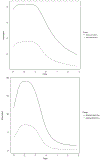Short form development for oral health patient-reported outcome evaluation in children and adolescents
- PMID: 29508207
- PMCID: PMC8185248
- DOI: 10.1007/s11136-018-1820-9
Short form development for oral health patient-reported outcome evaluation in children and adolescents
Abstract
Purpose: Children and adolescents are vulnerable to dental problems and oral diseases. This paper presents the development of two multi-item self-report scales for use in assessing oral health status of children and adolescents.
Methods: Following the Patient-Reported Outcome Measurement Information System framework, survey questions were designed using a newly developed conceptual model. These items were administered to 334 children and adolescents (8-17 years) along with concurrent dental exams. Exploratory and confirmatory factor analyses were conducted and the item response theory graded response model was used to estimate item parameters and oral health status scores and to identify short-form items. The items were selected by high level of information and wide coverage of different domains to assess Child Oral Health Status Index (COHSI) and treatment referral recommendations (RR).
Results: The long form consists of 28 items. The short-form includes 12 items (8 for COHSI and 7 for RR with 3 common items).The intra-class correlations between long form and short-form were 0.90 for COHSI and 0.87 for RR.
Conclusion: The short-forms provide a possible solution for the longstanding challenge of oral health evaluation for large populations of children and adolescents. The calibrated long form provides the foundation for computer adaptive test administration. These oral health assessment toolkits can be used for oral health screening, surveillance program, policy planning, and research.
Keywords: Children; Oral health; Patient-reported outcomes; Short-forms.
Conflict of interest statement
Figures
Similar articles
-
Computerized adaptive testing and short form development for child and adolescent oral health patient-reported outcomes measurement.Clin Exp Dent Res. 2020 Feb;6(1):124-133. doi: 10.1002/cre2.259. Epub 2019 Dec 28. Clin Exp Dent Res. 2020. PMID: 32067398 Free PMC article.
-
Developing Children's Oral Health Assessment Toolkits Using Machine Learning Algorithm.JDR Clin Trans Res. 2020 Jul;5(3):233-243. doi: 10.1177/2380084419885612. Epub 2019 Nov 11. JDR Clin Trans Res. 2020. PMID: 31710817 Free PMC article.
-
Development of a parents' short form survey of their children's oral health.Int J Paediatr Dent. 2019 May;29(3):332-344. doi: 10.1111/ipd.12453. Epub 2019 Jan 24. Int J Paediatr Dent. 2019. PMID: 30481390 Free PMC article.
-
Systematic review of factors influencing oral health-related quality of life in children in Africa.Afr J Prim Health Care Fam Med. 2019 Jul 24;11(1):e1-e12. doi: 10.4102/phcfm.v11i1.1943. Afr J Prim Health Care Fam Med. 2019. PMID: 31368323 Free PMC article.
-
Four-dimensional oral health-related quality of life impact in children: A systematic review.J Oral Rehabil. 2021 Mar;48(3):293-304. doi: 10.1111/joor.13066. Epub 2020 Aug 19. J Oral Rehabil. 2021. PMID: 32757443 Free PMC article.
Cited by
-
Dimensional Structure of the Early Childhood Oral Health Impact Scale.Iran J Med Sci. 2021 Mar;46(2):112-119. doi: 10.30476/ijms.2019.82060.0. Iran J Med Sci. 2021. PMID: 33753955 Free PMC article.
-
Artificial Intelligence Its Uses and Application in Pediatric Dentistry: A Review.Biomedicines. 2023 Mar 5;11(3):788. doi: 10.3390/biomedicines11030788. Biomedicines. 2023. PMID: 36979767 Free PMC article. Review.
-
AI-Driven Innovations in Pediatric Dentistry: Enhancing Care and Improving Outcome.Cureus. 2024 Sep 12;16(9):e69250. doi: 10.7759/cureus.69250. eCollection 2024 Sep. Cureus. 2024. PMID: 39398765 Free PMC article. Review.
-
Development of toolkits for detecting dental caries and caries experience among children using self-report and parent report.Community Dent Oral Epidemiol. 2019 Dec;47(6):520-527. doi: 10.1111/cdoe.12494. Epub 2019 Oct 1. Community Dent Oral Epidemiol. 2019. PMID: 31576591 Free PMC article.
-
Quantitative data collection approaches in subject-reported oral health research: a scoping review.BMC Oral Health. 2022 Oct 3;22(1):435. doi: 10.1186/s12903-022-02399-5. BMC Oral Health. 2022. PMID: 36192721 Free PMC article.
References
-
- U.S. Department of Health and Human Services (USDHHS), Office of Disease Prevention and Health Promotion. (2000). Healthy People 2010. Washington, DC: U.S. Government Printing Office.
-
- Munoz KA, Krebs-Smith SM, Ballard-Barbash R, & Cleve-land LE (1997). Food intakes of US children and adolescents compared with recommendations. Pediatrics, 100(3), 323–329. - PubMed
-
- Frary CD, Johnson RK, & Wang MQ (2004). Children and adolescents’ choices of foods and beverages high in added sugars are associated with intakes of key nutrients and food groups. Journal of Adolescent Health, 34(1), 56–63. - PubMed
-
- Kalsbeek H, & Verrips G (1994). Consumption of sweet snacks and caries experience of primary school children. Caries- Research, 28(6), 477–483. - PubMed
MeSH terms
Grants and funding
LinkOut - more resources
Full Text Sources
Other Literature Sources
Medical



